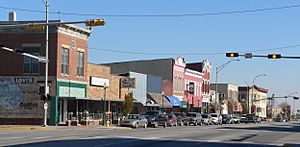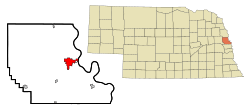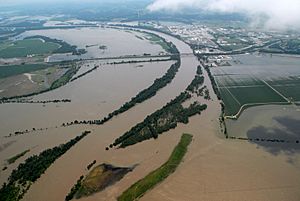Blair, Nebraska facts for kids
Quick facts for kids
Blair, Nebraska
|
|
|---|---|

Washington Street in Blair, November 2010
|
|

Location of Blair within Washington County and Nebraska
|
|
| Country | United States |
| State | Nebraska |
| County | Washington |
| Government | |
| • Type | Mayor-council government |
| Area | |
| • Total | 5.53 sq mi (14.32 km2) |
| • Land | 5.51 sq mi (14.27 km2) |
| • Water | 0.02 sq mi (0.05 km2) |
| Elevation | 1,089 ft (332 m) |
| Population
(2020)
|
|
| • Total | 7,790 |
| • Density | 1,413.54/sq mi (545.78/km2) |
| Time zone | UTC-6 (Central (CST)) |
| • Summer (DST) | UTC-5 (CDT) |
| ZIP codes |
68008-68009
|
| Area code(s) | 402 |
| FIPS code | 31-05350 |
| GNIS feature ID | 2394184 |
Blair is a city in and the county seat of Washington County, Nebraska, United States. The population was 7,990 at the 2010 census. Blair is a part of the Omaha-Council Bluffs Metropolitan Statistical Area.
Contents
History
Blair was platted in 1869 when the Sioux City and Pacific Railroad was extended to that point. It was named for railroad magnate John Insley Blair, who was credited with bringing the railroad to town. Blair was incorporated as a city in 1872. Within its first year, Blair was designated county seat.
In March 1869, a small child playing on a railroad turntable in town was injured on the turntable. The father sued the railway for damages, leading all the way up to the Supreme Court of the United States in the 1873 case Sioux City & Pacific Railroad Co. v. Stout.
In 1874, during the Panic of 1873, a grasshopper storm enveloped the region. Many Nebraskans were faced with starvation. An organization, the Nebraska Relief and Aid Society was formed in order to help affected persons. A law was passed by congress awarding $100,000 relief, and many Blair citizens were awarded money. Both the newspapers and the railroads in the region helped transport supplies free of charge. Both the Nebraska State Guard and the United States Army helped distribute food and clothing.
Construction of the Chicago and Northwestern Bridge across the Missouri River was authorized by an Act of Congress on June 27, 1882. Construction began in September 1882, and it was open for rail traffic in November 1883. The total cost of the bridge was $1.13 Million ($34.2 Million in 2023). The first automobile bridge was opened to traffic in 1929.
In 1916, Blair was awarded a $10,000 grant to build a Carnegie Library. Unfortunately, an electrical fire occurred on the night of July 23, 1973, and the historic library was deemed a total loss.
On April 26, 2024, portions of Blair were struck by a large EF4 tornado, destroying or damaging dozens of homes.
Geography
According to the United States Census Bureau, the city has a total area of 5.51 square miles (14.27 km2), of which 5.49 square miles (14.22 km2) is land and 0.02 square miles (0.05 km2) is water.
Blair is located in the Loess Hills, surrounded on all sides by rolling hills and the Missouri river valley.
Climate
| Climate data for Blair, NE (1991-2020, coordinates:41°33′13″N 96°08′26″W / 41.5536°N 96.1406°W) | |||||||||||||
|---|---|---|---|---|---|---|---|---|---|---|---|---|---|
| Month | Jan | Feb | Mar | Apr | May | Jun | Jul | Aug | Sep | Oct | Nov | Dec | Year |
| Mean daily maximum °F (°C) | 31.3 (−0.4) |
36.5 (2.5) |
50.4 (10.2) |
61.9 (16.6) |
72.7 (22.6) |
81.8 (27.7) |
85.6 (29.8) |
83.4 (28.6) |
77.2 (25.1) |
65.4 (18.6) |
49.3 (9.6) |
36.2 (2.3) |
61.0 (16.1) |
| Daily mean °F (°C) | 22.2 (−5.4) |
26.7 (−2.9) |
38.8 (3.8) |
49.8 (9.9) |
61.4 (16.3) |
71.1 (21.7) |
75.1 (23.9) |
73.1 (22.8) |
65.4 (18.6) |
53.4 (11.9) |
38.6 (3.7) |
27.1 (−2.7) |
50.2 (10.1) |
| Mean daily minimum °F (°C) | 13.0 (−10.6) |
16.9 (−8.4) |
27.2 (−2.7) |
37.7 (3.2) |
50.2 (10.1) |
60.4 (15.8) |
64.7 (18.2) |
62.8 (17.1) |
53.5 (11.9) |
41.4 (5.2) |
28.0 (−2.2) |
18.1 (−7.7) |
39.5 (4.2) |
| Average precipitation inches (mm) | 0.76 (19) |
0.94 (24) |
1.86 (47) |
3.21 (82) |
4.77 (121) |
4.94 (125) |
3.34 (85) |
3.92 (100) |
3.30 (84) |
2.45 (62) |
1.36 (35) |
1.26 (32) |
32.11 (816) |
| Average dew point °F (°C) | 15.9 (−8.9) |
19.8 (−6.8) |
28.5 (−1.9) |
37.4 (3.0) |
49.4 (9.7) |
60.5 (15.8) |
66.5 (19.2) |
65.0 (18.3) |
55.4 (13.0) |
41.2 (5.1) |
29.7 (−1.3) |
20.9 (−6.2) |
40.8 (4.9) |
| Source 1: NOAA | |||||||||||||
| Source 2: PRISM Climate Group (precipitation-dew point) | |||||||||||||
Demographics
| Historical population | |||
|---|---|---|---|
| Census | Pop. | %± | |
| 1870 | 494 | — | |
| 1880 | 1,317 | 166.6% | |
| 1890 | 2,069 | 57.1% | |
| 1900 | 2,970 | 43.5% | |
| 1910 | 2,584 | −13.0% | |
| 1920 | 2,702 | 4.6% | |
| 1930 | 2,791 | 3.3% | |
| 1940 | 3,289 | 17.8% | |
| 1950 | 3,815 | 16.0% | |
| 1960 | 4,931 | 29.3% | |
| 1970 | 6,106 | 23.8% | |
| 1980 | 6,418 | 5.1% | |
| 1990 | 6,860 | 6.9% | |
| 2000 | 7,512 | 9.5% | |
| 2010 | 7,990 | 6.4% | |
| 2020 | 7,790 | −2.5% | |
| U.S. Decennial Census 2013 Estimate |
|||
2020 census
The 2020 United States census counted 7,790 people, 3,157 households, and 2,015 families in Blair. The population density was 1,413.8 per square mile (545.9/km2). There were 3,299 housing units at an average density of 598.7 units per square mile (231.2 units/km2). The racial makeup was 92.62% (7,215) white, 0.41% (32) black or African-American, 0.15% (12) Native American, 0.53% (41) Asian, 0.04% (3) Pacific Islander, 1.27% (99) from other races, and 4.98% (388) from two or more races. Hispanic or Latino of any race was 2.0% (170) of the population.
Of the 3,157 households, 36.5% had children under the age of 18; 51.2% were married couples living together; 28.5% had a female householder with no husband present. 31.8% of households consisted of individuals and 14.4% had someone living alone who was 65 years of age or older. The average household size was 2.4 and the average family size was 3.0.
27.6% of the population was under the age of 18, 8.0% from 18 to 24, 23.6% from 25 to 44, 23.7% from 45 to 64, and 17.6% who were 65 years of age or older. The median age was 39.2 years. For every 100 females, the population had 91.4 males. For every 100 females ages 18 and older, there were 83.3 males.
The 2016-2020 5-year American Community Survey estimates show that the median household income was $57,274 (with a margin of error of +/- $7,379) and the median family income $76,838 (+/- $17,661). Males had a median income of $51,769 (+/- $5,822) versus $29,811 (+/- $7,842) for females. The median income for those above 16 years old was $39,382 (+/- $3,150). Approximately, 11.6% of families and 13.6% of the population were below the poverty line, including 18.7% of those under the age of 18 and 7.9% of those ages 65 or over.
2010 census
At the 2010 census there were 7,990 people, 3,110 households, and 2,005 families living in the city. The population density was 1,455.4 inhabitants per square mile (561.9/km2). There were 3,351 housing units at an average density of 610.4 units per square mile (235.7 units/km2). The racial makeup of the city was 96.4% White, 0.8% African American, 0.3% Native American, 0.3% Asian, 0.1% Pacific Islander, 1.0% from other races, and 1.1% from two or more races. Hispanic or Latino of any race were 2.9%.
Of the 3,110 households 33.3% had children under the age of 18 living with them, 50.5% were married couples living together, 10.6% had a female householder with no husband present, 3.3% had a male householder with no wife present, and 35.5% were non-families. 30.3% of households were one person and 13.4% were one person aged 65 or older. The average household size was 2.40 and the average family size was 3.01.
The median age was 36 years. 24.9% of residents were under the age of 18; 11.7% were between the ages of 18 and 24; 23.9% were from 25 to 44; 24.3% were from 45 to 64; and 15.3% were 65 or older. The gender makeup of the city was 47.9% male and 52.1% female.
Media
Blair is served by the local weekly newspaper Pilot-Tribune & Enterprise. Blair is also served by Walnut Radio Station 97.3 KOBM-FM and FM 94.7 KYTF-LP Blair Radio.
Points of interest
- Part of the Nebraska Statewide Arboretum collection
- From 1896 to 1954, Blair was home to Trinity Seminary, a school of the United Evangelical Lutheran Church
- Blair is located along the historic Lincoln Highway
- Tower of the Four Winds at Black Elk-Neihardt Park stands as a memorial to John G. Neihardt and Black Elk, the Lakota Sioux holy man
Education
It is a part of the Blair Community Schools which operates Blair High School.
Blair was home to the now defunct Dana College (1884 to 2010).
Notable people
- Kent Bellows - artist
- Clete Blakeman - professional football official
- Bob Cerv - baseball player
- Bill Danenhauer - professional wrestler
- Mike Hollingshead - photographer
- Megan Hunt - Nebraska State Senator, Legislative District 8
- Mick Mines - Nebraska state senator
- Otto Schmidt - US Navy Medal of Honor recipient
- Tom Seaton - baseball player
- Paul Simon - Democratic Congressman, Senator, and presidential candidate
- Rod Whitaker - novelist
See also
 In Spanish: Blair (Nebraska) para niños
In Spanish: Blair (Nebraska) para niños


